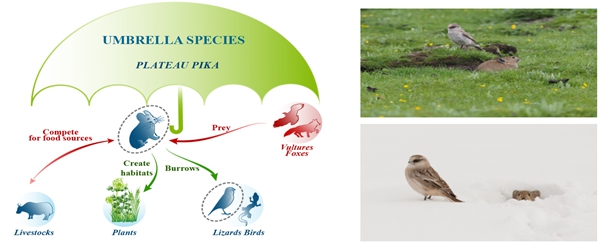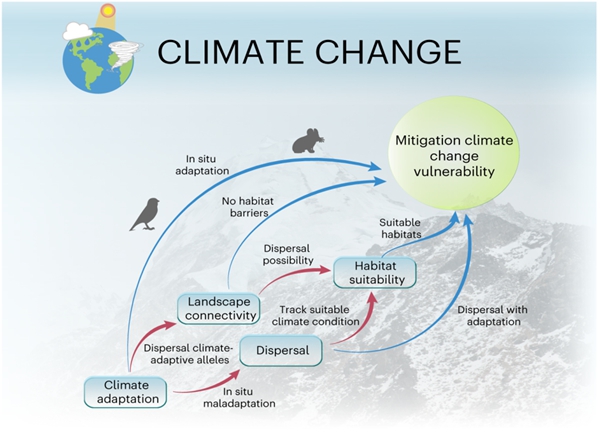How species cope with the on-going climate change is critical for avoiding an exacerbated loss of biological diversity. Since species may respond idiosyncratically to the climate change, studies of the interaction between ecological keystone species and those species that co-evolve with them can help the community to implement better-informed conservation policies for the future. The Qinghai-Tibetan Plateau (QTP) is the world’s highest plateau with an average elevation of 4,500 m above sea level. This extreme high-elevation environment has driven the evolution of an exceptional biodiversity and endemism. The plateau pika (Ochotona curzoniae), a keystone species of the alpine grassland of the QTP, is critical for the dynamic equilibrium and sustainability of this ecosystem because of its burrowing behaviour and being primary prey for several predators (Figure 1). One fascinating example of this is that the burrows of the plateau pika provide nesting places for the two species of snowfinches (Onychostruthus taczanowskii and Pyrgilauda ruficollis). This particular behaviour of burrow-sharing has fascinated people since the early 3rd century BC, as is documented in “The Classic Mountains and Seas”, an ancient Chinese account of the natural fauna and flora.
In a recently published research article entitled “Alpine burrow-sharing mammals and birds show similar population-level climate change risks” in Nature Climate Change, Yilin Chen and colleagues have combined ecological genomic, ecological niche modelling and landscape genetic approaches to evaluate population-level responses to future climate change in the plateau pika and two species of snowfinches. They studied how the interplay between local climate adaptation, migration, habitat suitability and landscape connectivity affect the vulnerability of species to climate change. For example, when the climate change is fast, local populations need to rapidly adapt to the changing conditions to avoid extirpation. This in situ climate adaptation may mitigate the population’s risk to climate change, but in a situation with an in situ maladaptation, i.e. when the climate change is beyond the tolerance-level of the population, it may need to migrate in order to track suitable climate conditions and thus avoid extirpation. Consequently, if climate-adapted alleles can disperse to areas where the future climate conditions are similar to those they are pre-adapted to, i.e., migration with adaptation, the risk of extirpation can be reduced. What areas that may hold suitable future climate conditions can be predicted by ecological niche modeling, i.e., habitat suitability. Niches that persist despite the climate change can be regarded as stable areas to which populations may migrate. The ability of a population to migrate also depends on landscape connectivity because habitat barriers may prevent dispersal (Figure 2).
To investigate whether rapid adaptation in climate-sensitive species in the high-elevation QTP can keep pace with the climate change, the authors measured genetic variation of climate-associated loci for the three species and modeled the risks posed by climate change at the population level. By simultaneously estimating multiple metrics of genetic maladaptation and considering both the migration capacity and landscape barriers, the authors show that most populations in the southwestern parts of the distribution ranges will not tolerate the predicted future climate conditions. Conversely, the climate warming is predicted to cause only minor disruptions for the populations living in the northeastern parts of the distribution ranges, which thus can serve as climate conservation hotspots, i.e., climate refugia for the many alpine endemics that constitute an important part of the global biodiversity.
By comparing the climate change maladaptation and ecological niche shifts to future climate change, the authors found that the keystone species and the co-evolving species show similar population-level patterns of vulnerability to climate change. Keystone species are often regarded as potential umbrella species, but it has been questioned whether this conservation concept can be applied in regions affected by climate change. The results of the current study demonstrate that ecological key species (umbrella species) can be used as an indicator to mirror the risks of climate change faced by other species that are co-evolving with it, and thus assisting in the conservation management for the whole community. In particular, by combining multiple climate change risk assessments in a group of co-evolving species, this study provides a novel way to comprehensively assess population-level climate change vulnerability beyond using a single species and/or modeling prediction alone.
URL: https://www.nature.com/articles/s41558-023-01772-8
Contact:
Qu Yanhua
Institute of Zoology Chinese Academy of Sciences
Tel: 86-64807280
E-mail: quyh@ioz.ac.cn
Web: http://english.ioz.cas.cn/

Figure 1. As a “keystone species” of the alpine grassland ecosystem on the Qinghai-Tibetan Plateau, the plateau pika is critical for its dynamic equilibrium and sustainability. Snowfinches have co-evolved with the plateau pika by utilizing their burrows for nesting (Image by Deyan Ge and Chao Zhao).

Figure 2. Climate adaptation, dispersal with adaptation, habitat suitability and landscape connectivity may act alone (blue arrows) or interact with other processes (red arrows) to mitigate risks caused by the climate change.


